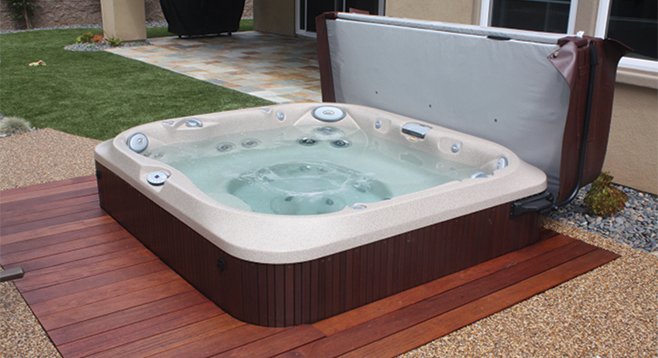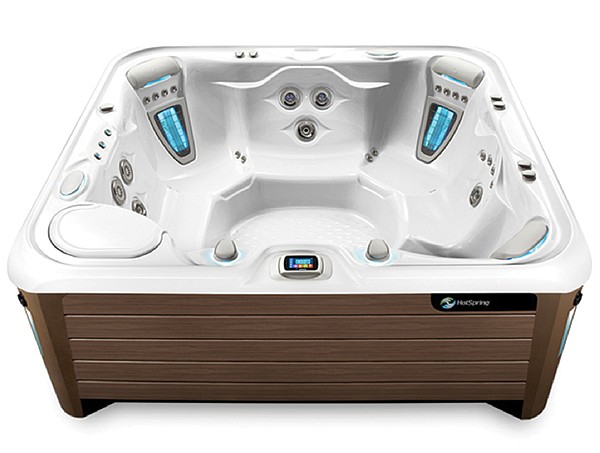 Facebook
Facebook
 X
X
 Instagram
Instagram
 TikTok
TikTok
 Youtube
Youtube

“I can’t afford a pool,” lamented my friend Shawn.
“So what?” I replied. “Grown-ups just want to lounge in the hot tub. And it’s less water, and it feels great on your back.”
Jay Gavin, owner of Aqua Paradise in Rancho Bernardo (858-675-7727; aquaparadiseca.com), advised, “The biggest thing to think about is how much room you have to work with. Then you have to consider whether or not the site can accept a hot tub. Is there any way to get it into the yard? Generally, it gets wheeled in on its side.” That one isn’t quite as essential, however. “If we have to, we can crane them in. We can even use a helicopter. Finally, can you hook it up to your electrical supply? There are hot tubs that operate on 120 volts, but the vast majority use 240 and give higher performance. It’s a good idea to have an electrician come out first and assess your situation. We can recommend some that know exactly what’s needed for a hot tub.”
Gavin deals exclusively in Jacuzzi-brand tubs. “They have four different series in four different price categories. They go from $4795 all the way up to $16,000, but most people buy in the $6500 to $9000 range. After you figure your budget, decide on your seating arrangement: do you want something with a lounge seat or a more traditional free-seating arrangement? Then we figure out the size, and that usually leaves people with two tubs to choose from.”
All Jacuzzis are equipped with a filtration system. Recently, that has been supplemented, across the line, with a CleaRay ultraviolet-light system to help neutralize bacteria. “It means that you’ll use less sanitizer,” said Gavin. “I tell people that the most important thing for making your hot tub last as long as possible is to maintain the water chemistry. You use the sanitizer, and you also need to check the pH every week with a test strip. Plus, you need to spray the filter out on a monthly basis and drain and clean the whole tub quarterly.”

When it comes to sanitizers, Gavin prefers chlorine to bromine or other chlorine alterantives. “I try to steer people that way, because chlorine is easiest to use, and with the supplementary systems that Jacuzzi has put in, the amount you need is very low, like that of tap water. So many people think of chlorine, and they think of hotel pools, where the levels are extremely high.”
Aqua Paradise does the service for all warranty work on the Jacuzzis. “Parts and labor are covered from two to five years, depending on the model. We do it all in-house from the beginning. We even give you an onsite orientation: we install the lifting mechanism on the lid, fill the tub, and teach you about functions and maintenance.”
Over at San Diego Hot Springs Spa in Clairemont Mesa (858-292-7727; sdhotspringspas.com), sales associate Eugene O’Connor stressed the importance of a “wet test — sitting in a tub filled with water — for any tub you are considering purchasing. Then he gave me a tour of his Hot Spring models. “Some of them have moto-massager jets that deliver streams of water down your entire back. They’re the only spa in the industry with that feature. The High Life model also has a supplementary ozone system that you use in conjunction with a mineral stick and a non-chlorine shock. Some people like that if they want to sanitize without chlorine. The prices on the High Life spas go from $6295 to $11,500. Though we also have spas from $2999 on up. Generally, they’ll have fewer features, but we do have two 7'-by-7' models that run $5795 and have 35-jet double-pump systems.”
Hot Springs spas have warrantees that run from two to five years, depending on the model. They do all their own service work, and O’Connor said that “the tubs of today should last 25 years if you keep the correct water chemistry. And they’re so energy efficient that keeping a tub at 102 degrees and using it six times a week, running the jets for 15 minutes and then leaving them off for 15 minutes, will cost you only $10 to $25 a month in electricity, depending on the size of your tub.”


“I can’t afford a pool,” lamented my friend Shawn.
“So what?” I replied. “Grown-ups just want to lounge in the hot tub. And it’s less water, and it feels great on your back.”
Jay Gavin, owner of Aqua Paradise in Rancho Bernardo (858-675-7727; aquaparadiseca.com), advised, “The biggest thing to think about is how much room you have to work with. Then you have to consider whether or not the site can accept a hot tub. Is there any way to get it into the yard? Generally, it gets wheeled in on its side.” That one isn’t quite as essential, however. “If we have to, we can crane them in. We can even use a helicopter. Finally, can you hook it up to your electrical supply? There are hot tubs that operate on 120 volts, but the vast majority use 240 and give higher performance. It’s a good idea to have an electrician come out first and assess your situation. We can recommend some that know exactly what’s needed for a hot tub.”
Gavin deals exclusively in Jacuzzi-brand tubs. “They have four different series in four different price categories. They go from $4795 all the way up to $16,000, but most people buy in the $6500 to $9000 range. After you figure your budget, decide on your seating arrangement: do you want something with a lounge seat or a more traditional free-seating arrangement? Then we figure out the size, and that usually leaves people with two tubs to choose from.”
All Jacuzzis are equipped with a filtration system. Recently, that has been supplemented, across the line, with a CleaRay ultraviolet-light system to help neutralize bacteria. “It means that you’ll use less sanitizer,” said Gavin. “I tell people that the most important thing for making your hot tub last as long as possible is to maintain the water chemistry. You use the sanitizer, and you also need to check the pH every week with a test strip. Plus, you need to spray the filter out on a monthly basis and drain and clean the whole tub quarterly.”

When it comes to sanitizers, Gavin prefers chlorine to bromine or other chlorine alterantives. “I try to steer people that way, because chlorine is easiest to use, and with the supplementary systems that Jacuzzi has put in, the amount you need is very low, like that of tap water. So many people think of chlorine, and they think of hotel pools, where the levels are extremely high.”
Aqua Paradise does the service for all warranty work on the Jacuzzis. “Parts and labor are covered from two to five years, depending on the model. We do it all in-house from the beginning. We even give you an onsite orientation: we install the lifting mechanism on the lid, fill the tub, and teach you about functions and maintenance.”
Over at San Diego Hot Springs Spa in Clairemont Mesa (858-292-7727; sdhotspringspas.com), sales associate Eugene O’Connor stressed the importance of a “wet test — sitting in a tub filled with water — for any tub you are considering purchasing. Then he gave me a tour of his Hot Spring models. “Some of them have moto-massager jets that deliver streams of water down your entire back. They’re the only spa in the industry with that feature. The High Life model also has a supplementary ozone system that you use in conjunction with a mineral stick and a non-chlorine shock. Some people like that if they want to sanitize without chlorine. The prices on the High Life spas go from $6295 to $11,500. Though we also have spas from $2999 on up. Generally, they’ll have fewer features, but we do have two 7'-by-7' models that run $5795 and have 35-jet double-pump systems.”
Hot Springs spas have warrantees that run from two to five years, depending on the model. They do all their own service work, and O’Connor said that “the tubs of today should last 25 years if you keep the correct water chemistry. And they’re so energy efficient that keeping a tub at 102 degrees and using it six times a week, running the jets for 15 minutes and then leaving them off for 15 minutes, will cost you only $10 to $25 a month in electricity, depending on the size of your tub.”
Comments